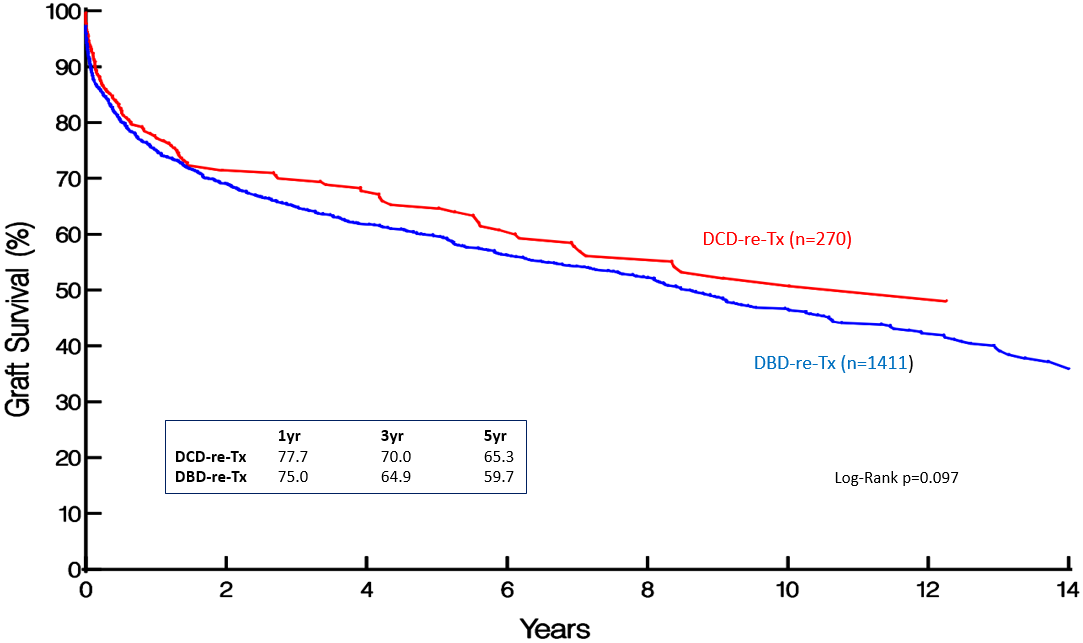Outcomes Following Liver Re-Transplantation for Delayed Graft Loss in Recipients of Donation After Circulatory Death Allografts in the United States
1Digestive Disease Institute, Cleveland Clinic Abu Dhabi, Abu Dhabi, United Arab Emirates, 2Department of Quantitative Health Sciences, Cleveland Clinic Foundation, Cleveland, OH, 3Center for Populations Health Research, Cleveland Clinic Foundation, Cleveland, OH
Meeting: 2022 American Transplant Congress
Abstract number: 523
Keywords: Donors, non-heart-beating, Liver transplantation, Outcome, Retransplantation
Topic: Clinical Science » Liver » 51 - Liver: Retransplantation and Other Complications
Session Information
Session Name: Retransplantation and Other Complications
Session Type: Rapid Fire Oral Abstract
Date: Tuesday, June 7, 2022
Session Time: 5:30pm-7:00pm
 Presentation Time: 6:30pm-6:40pm
Presentation Time: 6:30pm-6:40pm
Location: Hynes Room 313
*Purpose: Donation after circulatory death (DCD) liver transplant (LT) recipients have a higher likelihood of delayed graft loss due to Ischemic cholangiopathy (IC). Limited data exist regarding outcomes following re-transplantation (re-LT) after primary DCD LT. Our aim was to evaluate outcomes following re-LT for delayed graft loss in recipients of DCD LT, identify predictors of outcome and trends over time.
*Methods: Using SRTR, retrospective study cohorts were constructed of recipients undergoing re-LT ≥ 30 days following primary LT using either Donation after brain death (DBD) or DCD grafts, between 2005-2020, divided into 3 eras: era 1: 2005-2009; era 2: 2010-2014; era 3: 2015-2020. The 30-day time frame was chosen to evaluate impact of longer term graft failure from IC. Primary outcome measures were graft (GS) and patient survival (PS). A chi-square test was used for categorical and Student’s t-test for continuous variables. Survival comparison was performed using the Kaplan-Meier method with log-rank test and multivariable analysis of outcomes using Cox proportional hazard models.
*Results: 1681 patients underwent re-LT over the study period: 270 and 1411 respectively were recipients of DCD (DCD-re-Tx) and DBD (DBD-re-Tx) grafts in primary LT. Proportion of DCD-re-Tx remained steady over the study period, ranging from 15% of all re-Tx in era 1 to 19.3% in era 3. DCD-re-LT recipients were more likely be older, male with lower MELD score at re-Tx (22.3 ± vs. 25.9; p<.0001). GS in DCD-re-Tx and DBD-re-Tx were comparable at all time points studied (Fig 1). PS was also comparable: 1 Yr: 81.9 vs. 78; 3 Yr: 74.3 vs. 68.9; 5 Yr: 69.7 vs. 64.2 (p=0.07). GS and PS following DCD-re-LT improved significantly over time. Era 1 vs. era 2 vs. era 3: One-year GS: 67.4 vs. 81.1 vs. 85.6% (p=0.03) and one-year PS: 75 vs. 83.8 vs. 87.6% (p=0.03). On multivariable analysis, recipient, donor age and recipient BMI, but not graft type at primary LT (HR (95% CI): 1.19 (0.96 - 1.49), p=0.12) were predictive of GS and PS following liver re-Tx.
*Conclusions: In patients undergoing re-LT for delayed graft loss, outcomes of prior recipients of DCD grafts were comparable to DBD recipients and improved over time. With improving outcomes following primary DCD-LT, our observation should encourage ongoing efforts to optimize utilization of DCD grafts in the context of continued deceased donor organ shortage.
To cite this abstract in AMA style:
Kumar S, Lin S, Schold JD. Outcomes Following Liver Re-Transplantation for Delayed Graft Loss in Recipients of Donation After Circulatory Death Allografts in the United States [abstract]. Am J Transplant. 2022; 22 (suppl 3). https://atcmeetingabstracts.com/abstract/outcomes-following-liver-re-transplantation-for-delayed-graft-loss-in-recipients-of-donation-after-circulatory-death-allografts-in-the-united-states/. Accessed November 24, 2025.« Back to 2022 American Transplant Congress

